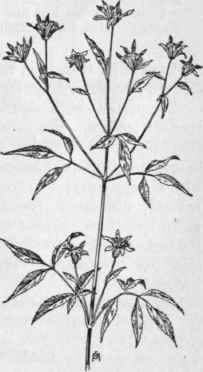Beggar-Ticks Bidens Frondosa, L. Bur Marigold, Stick-tight, Devil's Bootjack, Pitchfork Weed
Description
This section is from the book "A Manual Of Weeds", by Ada E. Georgia. Also available from Amazon: A Manual Of Weeds.
Beggar-Ticks Bidens Frondosa, L. Bur Marigold, Stick-tight, Devil's Bootjack, Pitchfork Weed
Native. Annual. Propagates by seed. Time of bloom: July to September. Seed-time: August to October.
Range: Throughout United States and southern British America. Habitat: Moist soil; gardens, fields, pastures, roadsides, and waste places.
All the Bidens are most annoying weeds and this one is perhaps the most so because it is everywhere. Stem two to five feet high, erect, smooth or nearly so, often purplish in color, with spreading branches. Leaves opposite, usually smooth, the lower ones generally five-lobed with terminal segments long-pointed and often again divided; upper ones three-parted or sometimes lance-shaped, all sharply toothed; petioles slender, and grooved on the upper side. Heads numerous, about a half-inch long, on slender peduncles; involucre double, with an outer row of five to eight leafy and spreading bracts, spatu-late, with edges hairy at base, much exceeding the heads in length; the inner row short, with scarious margins; rays, when present, yellow, very small and inconspicuous, sterile; disk-florets tubular, orange-yellow, five-toothed, perfect, and fertile. Achenes wedge-shaped, black, flat, ridged down the center of each face, the apex bearing two diverging, downwardly barbed awns, which enable them to attach themselves to clothing and to the coats of animals, particularly sheep, and so ensure a wide distribution. (Fig. 329.)

Fig. 329. - Beggar-ticks (Bidens frondosa). X 1/4.
Means Of Control
Prevent seed production by mowing, hoe-cutting, or hand-pulling the pests while in first bloom or earlier. Cultivation of the soil destroys it and good drainage is a discouragement to this weed, for it prefers the ground damp.
Continue to:


